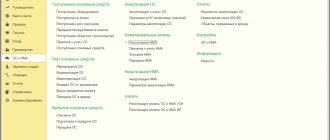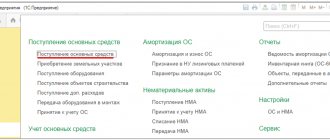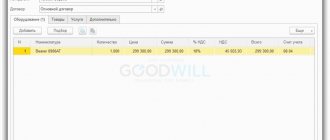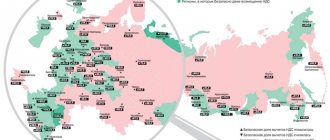Tools and equipment used in the enterprise become unusable over time. If they cannot be restored and cannot be used in the future, they must be excluded from the organization’s property by writing off. This operation must be properly documented.
The write-off of a tool that has become unusable takes place in a strictly established manner and must be documented in an act (clause of the Methodological Instructions for Accounting for Special Tools, approved by Order of the Ministry of Finance of the Russian Federation dated December 26, 2002 No. 135n). This document confirms the fact of write-off and reflects the main reasons for its publication. A well-drafted act will ensure the reliability of accounting, and regular write-off of worn-out instruments will reduce the tax burden on the organization.
The procedure and rules for registering a write-off act at an enterprise
Deregistration is a strictly regulated process, which is prescribed by law.
First of all, it is worth noting that a special commission is being assembled for this purpose. It necessarily includes financially responsible persons, usually from different structural divisions of the organization. Their responsibilities will include finding and inspecting any faults, damage or defects found.
The object being studied can be furniture, tools, equipment, inventory, inventory, household equipment, fixed assets, equipment, goods and everything that is on the balance sheet of the enterprise.
It is necessary not only to record the presence of violations on the form, but to fill out the act completely and indicate the reason for the marriage. You cannot make a write-off without good reason. In addition, the reason itself must be supported by a certain evidence base. There are instructions where the algorithm is clearly stated; you just need to follow them. For example, if materials are written off, additional supporting documents may be used.
What is suitable as a base:
- MOL reports that valuables were used;
- reporting on volumes of products produced (names, other data);
- written documentation that confirms the consumption of materials in quantities exceeding established standards (in addition, there must be justification for this fact);
- calculation, in which it becomes clear how much material costs are spent on one unit of product;
- other accounting or financial papers.
Inventory
Inventory and materials refer to current assets used in the implementation of statutory activities, spent in the production of products and provision of services and attributable to the increase in the cost of manufactured products with a useful life of up to one year.
International standards classify the following assets as inventory:
- Goods for sale or finished products.
- Currently in production.
- Inventories in the form of inventories for production, raw materials.
Domestic accounting divides inventory items into seven types:
- Materials.
- Fattening animals.
- IBP.
- Unfinished production.
- Finished products.
- Goods for sale.
- Goods shipped.
Accounting provides:
- Timeliness and reliability of the reflection of operations on the movement of property of the enterprise.
- Control and accounting of safety of inventory items.
- Identification and sale of surplus inventories.
- Distribution of inventory items by location and accounting items.
Due to the share in the cost of finished products and work in progress, accounting for inventory items is an important accounting task; reflecting the movement of current assets makes it possible to see where, how much and in what condition the values are located. Timely and correct reflection of the receipt and consumption of materials and other current assets makes it possible to ensure optimal financial results and prevent the acquisition of excess inventory.
How to properly prepare and execute a simple act of write-off of materials
This is a paper that must necessarily include information about the company and members of the commission. It is necessary to register:
- position and full name of each employee;
- names, quantity, price per piece and the entire volume regarding the items that will be written off.
Who will be included in the commission is approved by order of the director of the organization or production. The chairman who will be responsible for and manage the entire process must also be indicated there.
When all the data is entered into the act, everyone who certified the defectiveness of the product must sign. This confirms the accuracy of all recorded points.
At the end of the event, the chairman is the last to sign. He checks the correctness and correctness of the filling, and checks again, if necessary, the names of the values, their amounts and costs.
The last person to certify the document is the head of the organization. Without his attention, the paper will have no weight.
If everything is indicated and calculated correctly, then this is documentation with legal status. Let's figure out what this is about the write-off act.
Based on this entry, accounting reflects the book value of written-off materials or other inventory items. After this, the enterprise declines due to loss. All this must be reflected in a timely manner in the tax accounting of any legal entity so that there are no difficulties in balancing the balance.
This document does not have a unified template, so it is compiled taking into account simple recommendations and mandatory details. Otherwise, the shape and order of the fields can be any. The main thing is that it corresponds to a template that will be officially adopted in accordance with the nuances and characteristics of the company’s activities.
Let's look at what points are required and what this paper usually looks like.
What applies to workwear?
Special protective clothing includes items designed to protect workers from harmful and dangerous factors at work. In addition to providing workwear directly, the employer is obliged to provide conditions for storing, washing, repairing and disinfecting workwear.
It is necessary to distinguish between workwear and uniforms. The latter only indicates that the employee belongs to a given enterprise, but is not workwear as such. Accordingly, all of the following rules and regulations cannot be applied to it.
What details must be provided?
Some points are mandatory for every official company document. Let's figure out what you can't do without.
What to indicate:
- date of creation and name;
- name of company;
- content of the operation, quantities;
- persons responsible for implementation with full names and positions.
This form must be approved by the company management in advance. How to correctly make an act of writing off materials due to unsuitability - look in the primary documentation. If it does not yet exist, then compose it according to the model above and formalize it with a separate order from the manager.
Accounting entries
Here are a few examples of what wiring might look like in this case:
Chart of accounts.
Write-off of materials in the presence or absence of culprits.
Point at which expenses can be recognized
Materials that should have gone into production are written off as costs when they are released from the warehouse. That is, the right day to write them off is the one when the rest of the raw materials will be transferred into operation according to documents.
If you need to determine when items were actually used, you can use additional, non-core reporting forms. For example, a materials usage report would be suitable for this purpose. With this step, you can reduce the costs of the period by the cost of these raw materials, which were not processed, but must be written off.
For tax purposes, it is also important when exactly the products were actually consumed. In accounting you can reflect everything with the following entries:
Dt 20/23/25/26/29/44/97 Kt 10 or 16 – write-off.
Moreover, you can transfer materials even without indicating the purpose for their use. This happens if at the minute of vacation the name of the order or product, for the production of the batch or the name of the costs are not known.
Then everything can be written off as expenses based on a document that will be drawn up after the actual consumption of raw materials. Until the papers are signed, these materials remain with the recipient.
The very fact of vacation is reflected as an internal movement - within subaccounts 10.
Reasons for writing off fixed assets if depreciation has not yet ended
If an organization decides to write off a fixed asset that has not yet been depreciated (that is, has a non-zero residual value), then the reason for this is the inexpediency of further use of the asset.
If the OS has become unusable, it is better to remove it from the balance sheet and replace it with a more modern, productive, and fast one.
As a rule, the reason for premature write-off before the end of its useful life is:
- A breakdown is one that cannot be corrected, or can be corrected at significant costs that are not economically feasible.
- Reduced productivity due to wear and tear.
- Moral obsolescence – when a model does not meet modern requirements.
In all of these cases, equipment or other fixed assets that have become unusable should be written off.
How to reflect deteriorated materials and inventory items in a write-off act sample
If there are differences in the papers, then the tax service will have questions regarding the unjustifiedness of deregistration and reduction of expenses.
When there are several types or brands of a similar product in stock at once, misgrading becomes possible. Then, during the recalculation, it will be difficult to determine the culprits, and writing off another brand is quite problematic, especially if their values differ. And the identified surpluses will then have to be included in income.
Tax authorities usually compare the volumes written off with the number of inventories in accounting documents. For example, they can compare data on deregistered inventories. If they find discrepancies here, the inspector may refuse to recognize tax expenses and will remove the corresponding number of VAT deductions.
Who approves the papers
After we have figured out how to write an act for writing off damaged materials, it is worth figuring out who should sign it for it to become an official document.
In the “released” and “received” columns, the positions and full names of the responsible persons should be indicated. These people can actually confirm that the raw materials have gone into the activity and are used to generate income.
It is also advisable to add a line with the signature of the person who was responsible for this leave and allowed it. Usually this is the manager. warehouse or head of the supply department. This way, internal control over the vacation will be carried out and unauthorized spending will be avoided.
Synonym database 2:
fail | hand over | to spoil | to go crazy | spoil | refuse | crash | break down | fly | fall into disrepair
to go crazy | hand over | refuse | to clutter | fail | fall into disrepair | spoil | to spoil | break down | fly
to spoil | fall into disrepair | fail | deteriorate | go down | regress | change for the worse. Ant. improve
to fuck | to fuck | to fuck | to come across | get fucked up | jerk off | to wear oneself | to fuck | get fucked up | to give a damn | get fucked | get fucked up | get fucked up | get pissed off | get pissed off | to take a piss | get pissed off | take a piss | get pissed off | to take a piss | get fucked up | get fucked up | to get pissed off | get fucked up | to be manhandled | to come around | to be manhandled | get pissed off | to come around | to tempt | to get excited | to beckon | to get crazy | to get pissed off | get sick | to make a fool of | work out | get tired | to run out of steam | work hard | get drunk (to the point of passing out) | put your tongue on your shoulder | to swear | talk a lot | eat up to (dump | cut) | eat | get drunk | to eat | get drunk | get drunk | get drunk | to cut | slander | to lie | fall | to fall down | fall down | crash | hit | to thunder | to catch up | abyss | cover up | fail | lose | come into (unusable | inoperative state) | break down | break through | to perish | die | die | to gain | grab | prepare | become an ace | what (stolen | missing | lost | lost) | missed (opportunity) | died (chance)
fly | refuse | stay behind the staff | get a quote | come down | move | to be fired | depart | spoil | stretch out | break | hit the road | to head | to hoot | fly off | drive | run | to go crazy | to thunder | rush | to roll | to go | start running | quit | break down | rush | to roll | to collapse | take your feet in your hands | fly like a tumbler | rush like a bullet | fall | to fall down | to spoil | fail | to throw down | curl up | rush | slide | blow | go | pull | move | let down | take off | to overthrow | to squat | to gasp | to fight | to fall down | fall down | break loose | to fall down | fall into disrepair | excluded | hand over | drop out
fall into disrepair | to go crazy | fly | break down | spoil | to spoil | fail | hand over | refuse
hand over | to become weak | grow old | fly | exhausted | relax | break down | to become exhausted | become decrepit | relax | give away | get off | withstand | to spoil | distribute | weaken | refuse | weaken | spoil | to grow old | hand over with all the giblets | exchange for lentil soup | yield | push | grow old | to go crazy | betray | wear out | to run out of steam | to rent | barely move your legs | lose strength | fail | fall into disrepair | return | lose weight | charter | issue | deceive | retake
How can you write off production materials in accounting?
There are 3 options on how to do this:
- at cost;
- average cost;
- FIFO method.
When one of them is selected, it should be documented in the accounting policy. It will then need to be applied consistently in each period. It can be changed only if the chosen method is canceled at the legislative level.
If it is difficult for you to control these moments, then you should use special software in which keeping records will be easy even for a non-accounting specialist. To purchase this software, you should contact Cleverence. Our specialists will help you choose the right programs, install them and show you how to use them in order to spend a minimum of time taking into account all these details.
Nuances that arise when writing off materials in different industries
All the types mentioned above are the same for all areas of the company’s activities. But there are still small specifics for individual companies. Let's look into this.
Construction niche
The main difference here is that there is a wide variety of materials, and at the same time, the primary documentation is filled out with insufficient quality.
Here, in order to write off raw materials, you need to prepare a whole set of papers:
- monthly reports on consumption of inventories;
- estimates;
- production standards for expenses, which are approved by the general director;
- journals for recording work already completed.
Any construction organization conducts a monthly recalculation and assessment of consumed raw materials in open storage. During the month, their expenses are not taken into account, so they are inventoried 12 times a year. Based on the results of this event, the MPZ is written off.
Agricultural enterprises
Here, operations require specific primary documents:
- act of consumption of seeds and other prepared planting material;
- a statement according to which feed is accounted for in accordance with the plan;
- a document that is drawn up in the event of death or forced slaughter of animals and poultry.
But simply filling out these papers is not enough. It is important to provide a professional rationale for the event. For example, upon departure there must be a medical report indicating the diagnosis and cause of death. If an animal dies due to the fault of an employee, then the full price will be collected from the responsible employee.
What materials are subject to write-off?
Any property at enterprises is periodically written off. This even applies to vehicles. Management decides to proceed with write-off if:
Possession, use and disposal of materials becomes impossible due to destruction or destruction against the will of the owners.
Or because it is now impossible to establish where exactly this or that product is located.
It is impossible to use them for their intended purpose in the future, because the set of consumer properties has been partially or completely lost. Write-off also occurs due to moral and physical wear and tear.
If you were unable to go on vacation, you can write an application for compensation for unused vacation. For an example and rules of compilation, see the link.
This procedure is the same with movable and immovable property.
Valuation at which materials will be written off
Usually written off within the limits of natural loss, which goes to the account of production costs. And everything that turns out to be in excess of these norms will be used for other expenses or will be recovered from the guilty persons.
If we talk about low-value goods or raw materials that wear out quickly, the accountant can write them off at the cost at which they were recorded at the time of transfer to production. Or you can simply mark them evenly, little by little. This is acceptable if the estimated service life is more than 12 months. Depending on which method was chosen, it should be enshrined in the accounting policy.
Do you want to implement “Store 15”? Get all the necessary information from a specialist.
Thank you!
Thank you, your application has been accepted.
Postings depending on the basis
It is important to understand that write-off is a set of operations that must be documented. Account 10 is credited. The one on which these components could be stored is debited. We have listed their main types in the table.
| Dt | CT | Explanation |
| 20 | 10 | If written off to OP |
| 23 | If it is sent for the needs of auxiliary production | |
| 94 | Applies to cases of theft, end of life or obsolescence | |
| 99 | Write off everything that was damaged and lost as a result of a natural disaster or emergency |
These points are described in detail in special programs. Possible corresponding accounts are reflected there and cases when this can be used are described.
What needs to be done before filling out the form?
First, an audit of the property at disposal is carried out at the warehouse of material assets. During this procedure, they simply count how many quality units have accumulated and how many have already been damaged.
When the inventory is completed, they proceed to compiling a statement in the M29 form. It also displays materials for which write-off has become a mandatory requirement.
The next stage is the organization of a special inspection by the company’s technical department . The reports are sent a second time to accounting staff for additional study.
They already indicate the exact amount of material assets to be written off. A group of objects that have become completely unusable are separately identified.
When drawing up an act, separate isolation of materials that have become unusable is required. A separate room is used to accommodate them. Then they move on to sealing.
Persons who have become financially responsible put their signatures on the document. Without this, it is impossible to establish the very fact of loss of assets in the enterprise. And find out the full value of these assets.
There are several ways to determine the cost of materials.
- Calculation for specific units, for each separately. This is necessary to calculate materials with higher value.
- According to primary documents with later dates. To do this, divide by the total quantity by units of the total amount, which is reflected in the invoice upon receipt.
Without what is it impossible to draw up an act?
- A memo with information on the issuance and material movement over a certain period of time.
- The responsible person provides a separate report on the movement of materials from the warehouse.
The accounting employee prepares the document form.
What are the responsibilities of a storekeeper? The job description for a storekeeper can be found in this publication.
The main thing is that it complies with the policies adopted by the enterprise.








